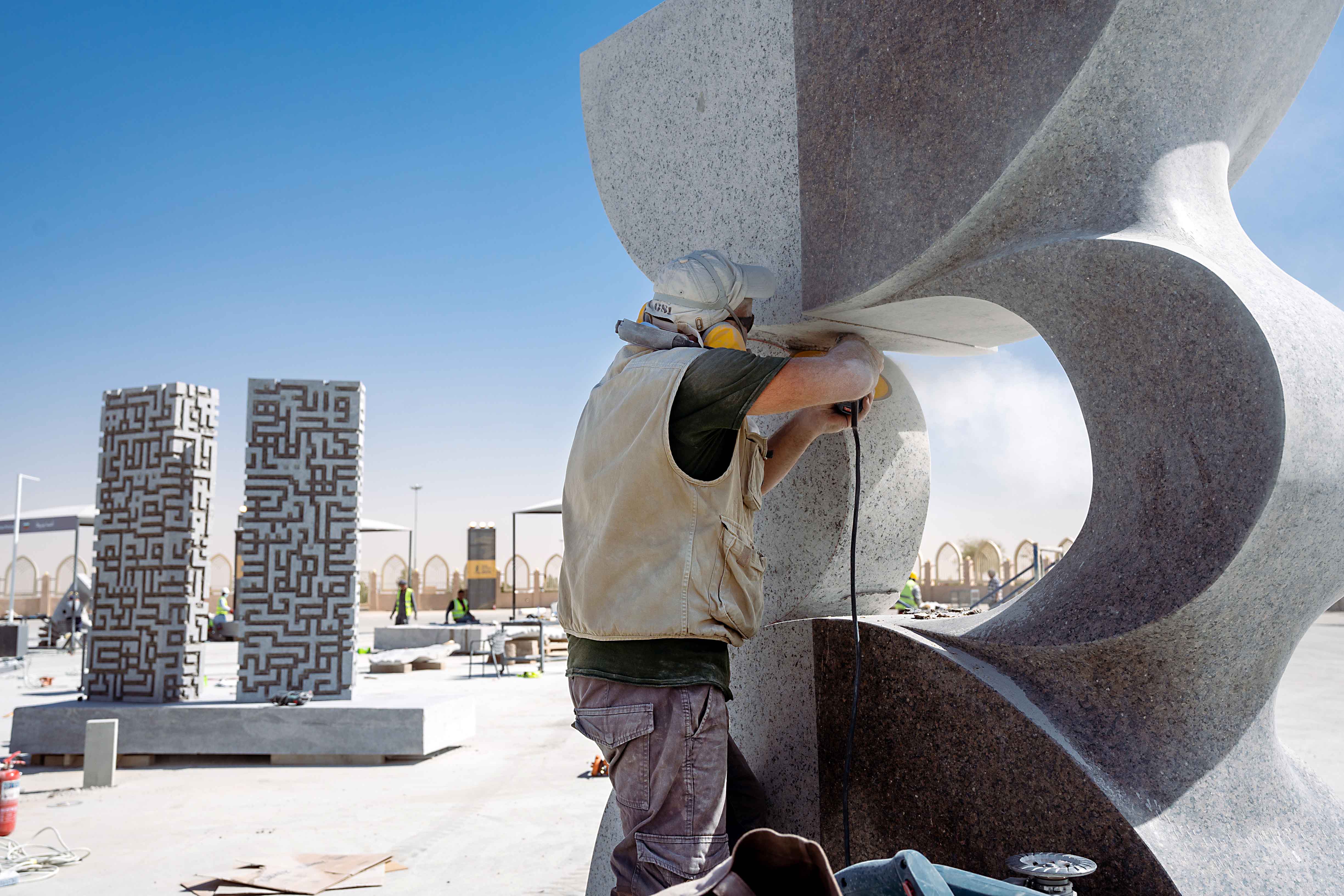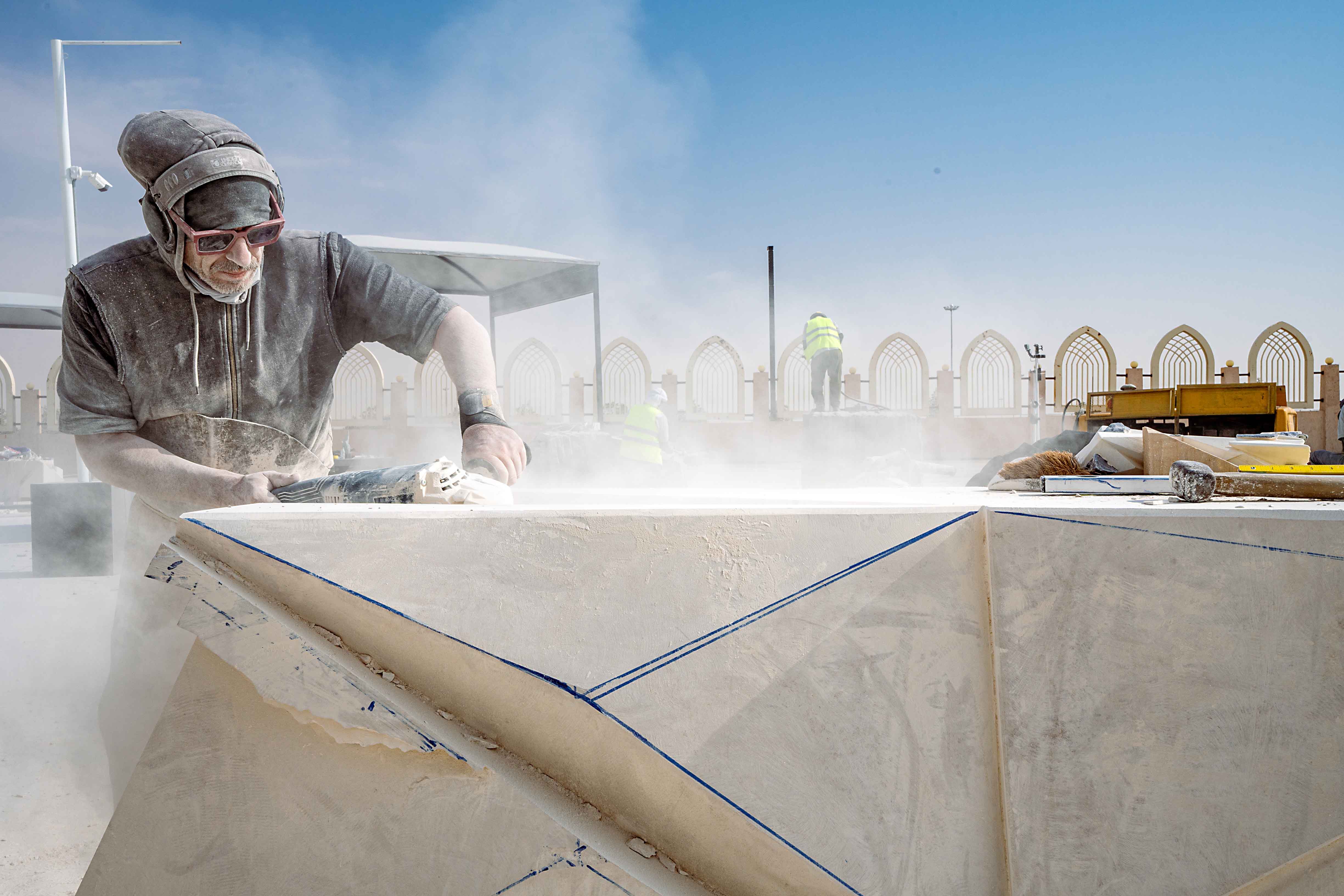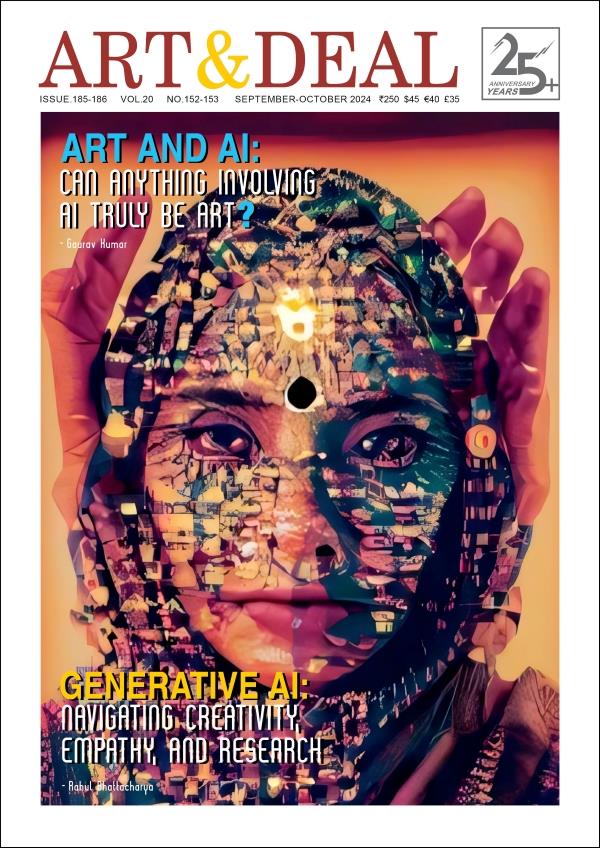This is the fourth edition of what has become central to the Riyadh Arts calendar in Riyadh and Saudi Arabia, The Tuwaiq Sculpture Symposium rewards its artists, selected from an open call, with a tenacity that serves them, as they take on the challenge of conceiving of and creating a free-standing sculpture. And that shared dedication is a measure of the slow-burning success, the event has had on the city; by inviting a geographical choice of artists to participate in this international event of sculpturing. This year thirty, from Spain, France, Italy, Romania, (and as far as Japan), among others, alongside more local and regional artists from The Kingdom, are each given a three-meter square measure of Riyadh stone (that for previous editions was Omani), and within what amounts to a month, are invited to convert it from rock into a representation that encompasses their individual emotional and material interests. This year’s theme Energy of Harmony, recalls, for its far-reaching title, a publication of the same name that purposefully examines Chi, the energy for all life forms and forces. As the late American sculptor Isamu Noguchi explained it when discussing weight, Tuwaiq’s sculptures are all born of the same material, of a similarly significant ‘weight’, alluding to ideas that are ‘weightless’. As an idiom and an overlap of essential ideas, it offers a promising way to intuit these sculptures and see them beyond their material, as objects of energy despite their standing static. Individual works involving the artist as author, the location and landscape, and the cultural vocabulary of the country and region, create their own arena for the artist to perform or live to sculpt in front of an audience.
With promotional phrases ‘encouraging artists to reimagine sculptural possibilities and capture manifestations of ephemeral processes to introducing and witness change’, such ideals are intended to motivate a swell of creativity amongst its participants, which invites everyone to feel they are contributing to a cultural and county-wide conversation, which underpins so much of what is to come in the Middle East.

Away from central Riyadh, located in Durrant, where the Arabian sands appear more present, as they turn into deserts the further away from the capital you go. The warmth of the weather’s welcome mirrors The Kingdom’s commitment to redesigning and decorating its major cities in line with Vision 2030. And as with previous editions the international presence isn’t just felt in the choice of artists from twenty different countries, it is the face of the curatorial team, led by Marke Wolynski, the panel speakers, including Future City’s Mark Davy, and Thomas Rieger, Konrad Fischer Galerie, together with an invited audience of press and artists, who all introduce something of everywhere else in the world, as an affirmative way of marking this event as international. Having since done away with a final prize, and runners-up, the event has become more of a celebration of creative interests, with every one of the participants holding ground, leading to a host of accompanying activities, including panel discussions, that introduce a wealth of ideas, that are never easily answered in their entirety.
Beyond the promising and at times problematic rhetoric, what is rewarding about this year’s symposium, is the number of Saudi women artists participating. Giving their perspective on what it is to make work under the umbrella of a very masculine practice. The German-French sculptor Hans Arp may have explained it best, when referring to his wife, Sophie Arp, saying of her, “By the example of her work, and her life, both of them bathed in clarity, showed me the right way. In her world, the high and the low, the light and the dark, the eternal and the ephemeral, are balanced in perfect equilibrium.” That as a vote of confidence, more than half a century later, offers a gratifying explanation for the achievement of these women of different ages and places in Saudi Arabia, able to express their visions of the world. Not as loose ideas, poems, or pencil drawings, but in stone, immovable and permanent evidence of themselves as creative individuals; and every one of their monuments speaks volumes of the desires, and direction the country is taking.
Artist Interview
Rajesh Punj: How have you felt about participating in this year’s Tuwaiq Sculpture?
Rajaa Alshafae: It was a great honour for me to participate this year, although it’s not my first time. I was one of the participants of the 3rd edition of 2021; so, to be a candidate for the second time in a row has been quite an achievement.
RP: And how important has it been to you to contribute and be part of something of this kind?
RA: It’s very important for me, It is one of the national art projects related to the Kingdom’s Vision for 2030, which aims, along with other art projects, to make the capital (Riyadh) an open-air art museum, a gallery without walls, so to speak. So, being a part of this as one of the contributing artists, I believe will be a milestone in my artistic career. Moreover, displaying my works in public is good documentation of my art for future generations.
RP: As ‘sculptors’ are the instruments and stones something you are familiar with?
RA: Absolutely, yes.
RP: Or is it that you use very different materials when making your work?
RA: It’s the same, nothing different.
RP: More widely, how is sculpting as a practice and profession received in Saudi Arabia?
RA: For years, painting, photography, and other arts dominated the art scene, at both the popular and official levels. As for sculpture, it did not receive as much attention, and this does not mean that there were no sculptors or interested people or even forums. There were, but on a local scale, and it wasn’t encouraged enough. Recently, with the interest of the Kingdom as part of Vision 2023, and the Riyadh Art program, audiences are starting to see the beauty and value of three-dimensional art, and I believe Saudis are happy to be seeing sculpture.
RP: I want to ask about your reaction to this year’s theme, Energy of Harmony, and what that meant for you.
RA: Frankly, it doesn’t take a long time for the design to crystallize in my head. The concept of harmony is found in everything around us. It’s everywhere, from within us, to the natural world, and even our human relationships. The latter is what I try to express being part of that.
RP: When was it that you originally started to create something from your interests and ideas?
RA: In 2007, that was the first time I made a stone sculpture, which I named Motherhood.
RP: And how have you managed to make that happen, in terms of access to materials and studio space?
RA: At the time, I was with a friend in her workshop, working with simple materials (soft stone, hammer, and chisel), that she gave me. The difficulties came with my ambition to work in stronger stone, particularly marble, and of the availability of power tools. At the time, as I mentioned earlier, sculpting was not a proven or popular field, and therefore it was not easy to have access to such stone. But that did not keep me from looking for solutions, and I eventually established my own studio, and now everything has become easier.
RP: As women artists, do you feel it an accomplishment to have contributed to Tuwaiq Sculpture?
RA: Of course, I do, men have always dominated sculpture, and when women participate it becomes a huge step forward, in showing that we are capable of the same level of creativity. I always say the issue is not a show of strength between men and women, but it is a matter of thought and creativity, and we can contribute to the field.
RP: When you think of art, what is it that comes to mind? And how much were you exposed to art and artworks as a child/young woman?
RA: Art is a way of life; I can’t imagine life without it. Art is a need that nourishes the soul and makes me calm and balanced, offering the ultimate sense of freedom. One that gives you wings to fly high without restrictions or any kind of limits. As a child, magazines were my only source of knowledge about the arts. Later, some specialized shows started to appear on television.
RP: Regarding that, who are the artists that you look to/admire in the Middle East?
RA: There are no specific artists, but I admire those who surprise me with their creativity and ideas.
RP: Other than art and aesthetics, what influences do you draw on when wanting to create works?
RA: Everything around me inspires and motivates me to do something. The Life we have around us is beautiful with its diversity, and contradictions, and the artist stops at the slightest sign and creates something beautiful and unexpected.
RP: For this year’s symposium you were all asked to work with Saudi stone, how did you feel about having fashioned something out of local material?
RA: I think that creating something for your country, while doing it in your homeland, is better with a local stone that is my opinion. This gave the artwork more value and authenticity; moreover, it educates people about the kinds of material we have here in Saudi Arabia.
RP: Did you look to each other, as women artists all participating in the same event?
RA: When the names of the participants were published, it was an overwhelming feeling to see four Saudi women participating in the same event, and this was happening for the first time. I felt proud of them and myself, and I think we all felt the same way, because we have opened the door to other women, and hope to encourage them.
RP: With that in mind, do you feel a responsibility to younger (women) artists wanting to do as you have done?
RA: To be honest, the responsibility has already taken its natural course, and I carry it, and I am happy to have that. Many young women have started calling me and asking about everything relating to sculpture, and how they can enter this field. Which has me enthused, and open to answering their questions. It is the encouragement these women are receiving from their families, and their consideration of me as a role model, that proves overwhelming.
RP: And what advice do you have for those wanting to follow in your footsteps?
RA: This is what I would say to them: do not hesitate, as everything starts with small steps and then grows. Also, do not let any difficulties stop you, as long as you have the passion and the ability, go for it and follow your dreams.
RP: Specific to this year’s event, can you explain your sculpture, the original idea, and of its physical realization?
RA: This year’s theme was Energy of Harmony and as I mentioned earlier, harmony exists all around us in everything; what attracts me the most is its impact and influence on human relationships, and so I chose one of those relationships to express this concept. Which is the beautiful relationship that exists between spouses. As we pursue to establish a strong, harmonious, and long-lasting relationship, we look for those elements that make that relationship work, and have its roots extend strong and go deep, so it can bloom with love in all directions. My sculpture’s title is ‘Let’s Blossom Together’.
RP: Were you happy with the final work?
RA: Working to a deadline is difficult, and doesn’t give you enough time to relax, to check and review your work, but overall, I’m satisfied and happy.
RP: As artists, how important are reading, drawing, and taking photographs, to your practice?
RA: It’s decisive, All these things that you mention are important for artists, as they refine and develop their skills. Observing and seeing the work of others is also important.
RP: And, of course, is nature and natural light, something that matters to you?
RA: Yes, of course. All the forms that the artist deals with are present around us naturally, and, I focus very much on the light and its direction when I start any design, as the light plays a big role in highlighting the details that describe my idea.
RP: How significant do you think art is to society?
RA: I believe that art in its various forms is very important for societies. Art is an important human need because of the profound impact it has on the human psyche, as it helps to create a balance within a person, and of shaping the personality. Therefore, I believe that it is one of the factors influencing the development of nations, their mentality, adapting their morals, and preserving cultures and civilizations.
RP: What do you feel you have learned from the other participants of the other nationalities involved, men and women alike?
RA: Many things. As an individual, being with people from different countries and cultural backgrounds enriches your knowledge. As a sculptor, having a chance to speak with very experienced professional sculptors and asking them about the field has been of great benefit, and an invaluable reward – you feel like you are in a classroom, and you wish that the class would never end.
RP: Does it make you want to show your work in completely different settings (countries)?
RA: Of course, this is one of my wishes, or to put it more clearly; it’s one of my future goals. Exhibiting in different countries is one of the ways that can help me to grow as a sculptor and expand my knowledge.
RP: Where would you wish your sculpture to appear with the symposium and exhibition having since ended?
RA: This matter is up to the organizer.
RP: What are you working on now?
RA: I am currently preparing to hold a personal exhibition, but I have not yet decided whether it will be only for sculptural works or paintings. I am working on both at the same time.
RP: What do you wish for from ‘Vision 2030’, for the arts and culture?
RA: I cannot ask for more because everything we dreamt of is happening little by little. We are truly living in the golden age of art and culture.
Read More>> Please Subscribe our Physical Magazine


